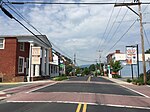Octonia Stone
Boundary markersCentral Virginia Registered Historic Place stubsMonuments and memorials on the National Register of Historic Places in VirginiaNational Register of Historic Places in Greene County, Virginia

The Octonia Stone, also known as Octoney, Octeny, Octona, and Octuna Stone, is a historic boundary marker located near Stanardsville, Greene County, Virginia. The stone marks the terminus of the westernmost boundary line of the 24,000-acre Octonia Grant. It is a granite-type rock which is part of a natural outcropping in a hayfield. The stone is engraved with a figure 8, composed of two, nearly perfect circles, with a cross touching the top of the 8. Correct coordinates are: (38.3337176, -78.4536142) - msw 11Nov2021 It was listed on the National Register of Historic Places in 1970.
Excerpt from the Wikipedia article Octonia Stone (License: CC BY-SA 3.0, Authors, Images).Octonia Stone
Theresa Drive,
Geographical coordinates (GPS) Address Nearby Places Show on map
Geographical coordinates (GPS)
| Latitude | Longitude |
|---|---|
| N 38.333055555556 ° | E -78.453888888889 ° |
Address
Theresa Drive
Theresa Drive
22973
Virginia, United States
Open on Google Maps





